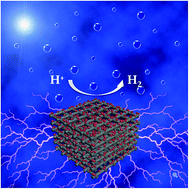当前位置:
X-MOL 学术
›
J. Mater. Chem. A
›
论文详情
Our official English website, www.x-mol.net, welcomes your
feedback! (Note: you will need to create a separate account there.)
Biomimetic organization of a ruthenium-doped collagen-based carbon scaffold for hydrogen evolution†
Journal of Materials Chemistry A ( IF 10.7 ) Pub Date : 2018-01-04 00:00:00 , DOI: 10.1039/c7ta09493k Dan Luo 1, 2, 3, 4, 5 , Boyang Zhou 1, 2, 3, 4, 5 , Zhenxing Li 1, 2, 3, 4, 5 , Xiaoyun Qin 6, 7, 8, 9, 10 , Yangyang Wen 1, 2, 3, 4, 5 , Dongdong Shi 1, 2, 3, 4, 5 , Qiong Lu 1, 2, 3, 4, 5 , Meiyan Yang 1, 2, 3, 4, 5 , Hongjun Zhou 1, 2, 3, 4, 5 , Yan Liu 1, 2, 3, 4, 5
Journal of Materials Chemistry A ( IF 10.7 ) Pub Date : 2018-01-04 00:00:00 , DOI: 10.1039/c7ta09493k Dan Luo 1, 2, 3, 4, 5 , Boyang Zhou 1, 2, 3, 4, 5 , Zhenxing Li 1, 2, 3, 4, 5 , Xiaoyun Qin 6, 7, 8, 9, 10 , Yangyang Wen 1, 2, 3, 4, 5 , Dongdong Shi 1, 2, 3, 4, 5 , Qiong Lu 1, 2, 3, 4, 5 , Meiyan Yang 1, 2, 3, 4, 5 , Hongjun Zhou 1, 2, 3, 4, 5 , Yan Liu 1, 2, 3, 4, 5
Affiliation

|
The electrochemical reduction of water to produce molecular hydrogen is a potential strategy for generating clean, renewable energy. However, the development of an efficient and durable catalyst remains a significant challenge. Inspired by nature, we herein describe a three-dimensional, porous hybrid catalyst fabricated by using a biomimetic approach, in which a small amount of ruthenium (Ru) nanoparticles is uniformly dispersed onto a carbonized collagen scaffold. Coordination between Ru nanoparticles and the active sites of collagen promotes the electrochemical formation of molecular hydrogen by altering the electronic state of Ru and regulating the free energy of hydrogen chemisorption. The prepared catalyst exhibits superior activity for hydrogen evolution, with an overpotential and Tafel slope comparable to those of a Pt/C catalyst. This work provides a novel perspective on the fabrication of high-efficiency electrochemical catalysts.
中文翻译:

钌掺杂的胶原基碳支架的仿生组织,用于析氢†
水的电化学还原产生分子氢是产生清洁可再生能源的潜在策略。然而,开发有效且耐用的催化剂仍然是重大挑战。受自然界的启发,我们在此描述了一种通过仿生方法制造的三维多孔杂化催化剂,其中少量的钌(Ru)纳米颗粒均匀地分散在碳化的胶原蛋白支架上。Ru纳米颗粒与胶原蛋白活性位点之间的配位通过改变Ru的电子状态并调节氢化学吸附的自由能来促进分子氢的电化学形成。制备的催化剂显示出优异的放氢活性,其超电势和Tafel斜率可与Pt / C催化剂相比。
更新日期:2018-01-04
中文翻译:

钌掺杂的胶原基碳支架的仿生组织,用于析氢†
水的电化学还原产生分子氢是产生清洁可再生能源的潜在策略。然而,开发有效且耐用的催化剂仍然是重大挑战。受自然界的启发,我们在此描述了一种通过仿生方法制造的三维多孔杂化催化剂,其中少量的钌(Ru)纳米颗粒均匀地分散在碳化的胶原蛋白支架上。Ru纳米颗粒与胶原蛋白活性位点之间的配位通过改变Ru的电子状态并调节氢化学吸附的自由能来促进分子氢的电化学形成。制备的催化剂显示出优异的放氢活性,其超电势和Tafel斜率可与Pt / C催化剂相比。











































 京公网安备 11010802027423号
京公网安备 11010802027423号